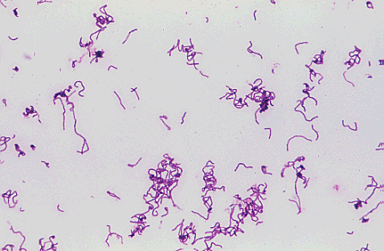LACTOBACILLUS
LACTOBACILLUS
(under the microscope)
 Most species of this non-spore-forming bacterium ferment glucose into lactose, hence the name
Lactobacillus. The most common application of Lactobacillus is industrial, specifically
for dairy production. This genus also contains several bacteria that make up part of the natural flora of the
human vagina. Because of their ability to derive lactic acid from glucose, these bacteria create an acidic environment
which inhibits growth of many bacterial species that lead to urogenital infections. Lactobacillus is generally harmless
to humans, rarely inciting harmful infections or diseases. Treatment of this vancomycin-resistant microbe usually
consists of high doses of penicillin in combination with gentamycin.
Most species of this non-spore-forming bacterium ferment glucose into lactose, hence the name
Lactobacillus. The most common application of Lactobacillus is industrial, specifically
for dairy production. This genus also contains several bacteria that make up part of the natural flora of the
human vagina. Because of their ability to derive lactic acid from glucose, these bacteria create an acidic environment
which inhibits growth of many bacterial species that lead to urogenital infections. Lactobacillus is generally harmless
to humans, rarely inciting harmful infections or diseases. Treatment of this vancomycin-resistant microbe usually
consists of high doses of penicillin in combination with gentamycin.
LABORATORY INDICATIONS:
- Catalase -
- Lactic acid production from glucose
- Growth on tomato juice agar




Copyright © 1995 University of Texas - Houston Medical School, DPALM MEDIC, All rights reserved.
 Most species of this non-spore-forming bacterium ferment glucose into lactose, hence the name
Lactobacillus. The most common application of Lactobacillus is industrial, specifically
for dairy production. This genus also contains several bacteria that make up part of the natural flora of the
human vagina. Because of their ability to derive lactic acid from glucose, these bacteria create an acidic environment
which inhibits growth of many bacterial species that lead to urogenital infections. Lactobacillus is generally harmless
to humans, rarely inciting harmful infections or diseases. Treatment of this vancomycin-resistant microbe usually
consists of high doses of penicillin in combination with gentamycin.
Most species of this non-spore-forming bacterium ferment glucose into lactose, hence the name
Lactobacillus. The most common application of Lactobacillus is industrial, specifically
for dairy production. This genus also contains several bacteria that make up part of the natural flora of the
human vagina. Because of their ability to derive lactic acid from glucose, these bacteria create an acidic environment
which inhibits growth of many bacterial species that lead to urogenital infections. Lactobacillus is generally harmless
to humans, rarely inciting harmful infections or diseases. Treatment of this vancomycin-resistant microbe usually
consists of high doses of penicillin in combination with gentamycin.



